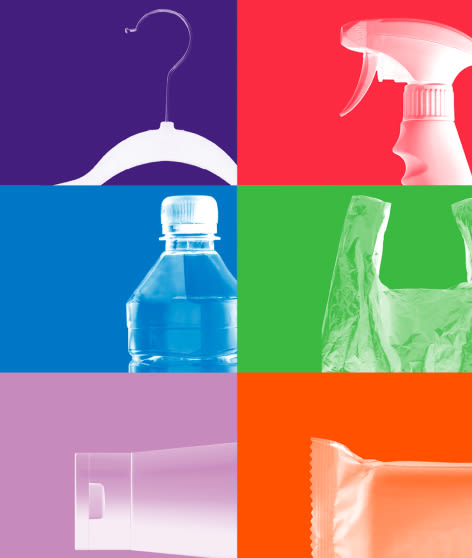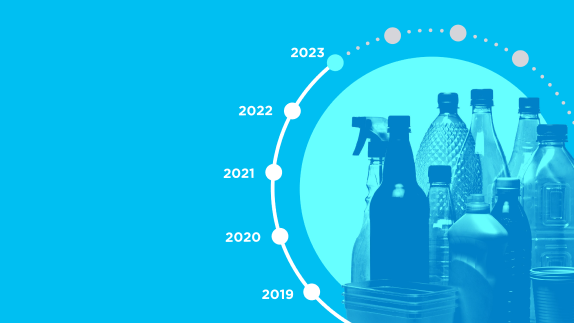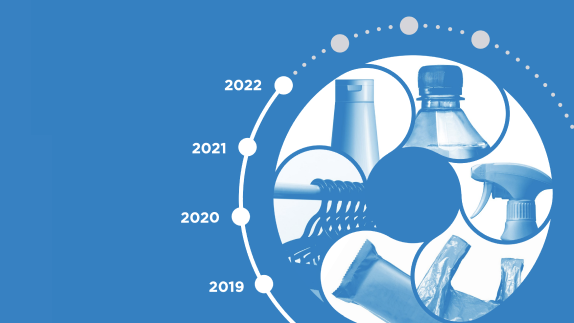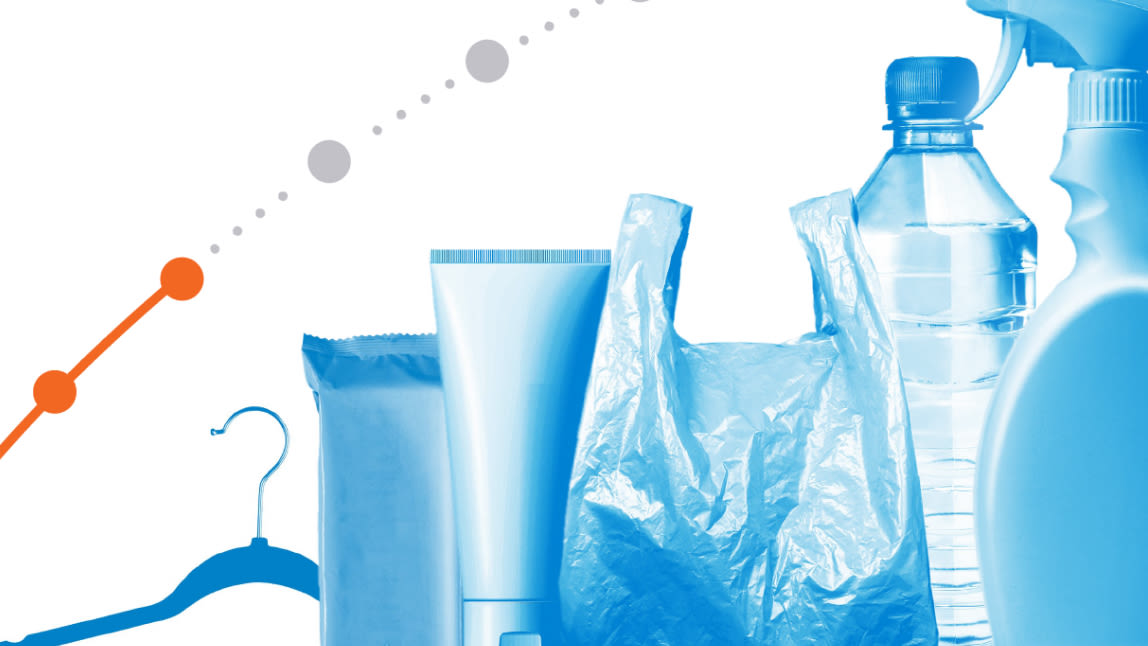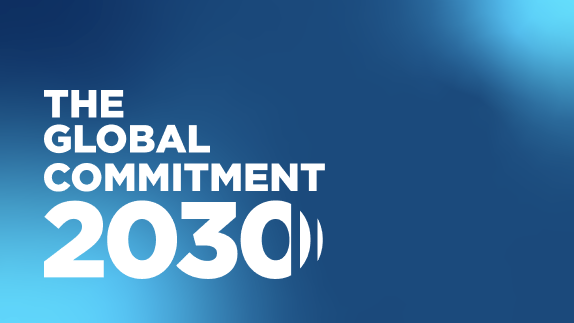Published as part of the Global Commitment Progress Report 2022 by the Ellen MacArthur Foundation and UN Environment Programme
Overall trends
In 2021, most of the sector signatories (two out of three) decreased their use of virgin plastic packaging. The two signatories decreased their use of virgin plastic packaging, predominantly by increasing their post-consumer recycled (PCR) content along with a slight decrease in plastic packaging weight for one of the signatories. Overall, compared to 2018, the amount of virgin plastic packaging used by the signatories decreased by 10% on average.
Two out of the three signatories made progress on their 100% reusable, recyclable, compostable (RRC) target. Cosmetics signatories have been eliminating or reducing materials and additives such as PETG in rigid packaging, undetectable carbon black, and pumps and triggers to improve the recyclabilityrecyclabilityThe ease with which a material can be recycled in practice and at scale. of their packaging. However, despite a previous increase in reusability, the sector’s share of reusable plastic packaging decreased by 0.4 percentage points on average for the first time in 2021.
Actions to accelerate progress
Accelerate upstream innovation solutions which eliminate the need for single-use packaging. In recent years, cosmetics companies have launched product formats that eliminate or reduce the need for single-use packaging, including bar formats and in-store refill stations. However, this remains concentrated on a few product lines and, therefore, signatories are encouraged to accelerate these efforts and to collaborate – both with sector companies as well as their suppliers and innovators – to identify and overcome current barriers.
Addressing non-recyclable plastic packaging should remain a key priority as it represents a large part of signatories’ portfolios. Cosmetic signatories have progressed on designing their packaging to be more recyclable. However, there remains a high proportion of non-recyclable plastic packaging (62%), mostly in the form of PE tubes, PP pots, tubs and trays, consumer-facing flexible packaging such as pouches, and small-format packaging. Companies need to urgently innovate away from such packaging as a priority, in addition to investing in recycling infrastructure.
Reduction targets
Average change in virgin plastic packaging from 2020 to 2021: +1.9%
In 2021, signatories have set 2025 targets to reduce their virgin plastic packaging (i) or total plastic packaging (ii) as part of the mandatory requirements to remain in the Global Commitment.
Trends
In 2021, all three signatories set a virgin reduction target, by 27% on average.
Between 2020 and 2021, the sector reported an increase in virgin plastic of 1.9%, driven by one signatory whose growth in plastic packaging outpaced progress on post-consumer recycled content. The remaining two decreased their use of virgin plastic packaging mostly through an increase in post-consumer recycled content.
Looking at the overall trend from 2018 to 2021, the sector decreased its virgin plastic packaging by an average of 10%.
Virgin reduction targets aim to decrease the total weight of virgin plastic in packaging, and should be underpinned by efforts on reuse and elimination in addition to increasing the use of recycled content.
Total reduction targets aim to reduce the total weight of plastic packaging.
For more information about the reduction targets read the 2022 Progress Report
Elimination of problematic or unnecessary plastics packaging
Trends
Cosmetic signatories are commonly targeting multilayer materials, PETG in rigid packaging, and pumps and triggers to improve the recyclability of their packaging.
Signatories are taking action to eliminate plastic packaging (such as cellophane wrappers around perfume) and are implementing reusereuseThe repeated use of a product or component for its intended purpose without significant modification. solutions for some of their products. However, similar to last year, the focus remains on material substitution to mono-material plastics, removal of a pigment/additive, or lightweighting (together representing 75% of the elimination examples submitted), none of which eliminate the need for single-use packaging in the first place.
Highlights
Natura & Co. launched a range of solid bar formats for body and hair care, and plans to reduce the use of pumps by over 50%, by shifting to reuse models. The company also plans to fully eliminate clear mono-material B2C films by 2023, in addition to EPS, pigments/additives such as undetectable carbon black, and plastic windows by 2025.
In 2021, L’OCCITANE Group eliminated 21% of its plastic jars used for cream products – opting for refill models using reusable aluminium jars with 100% recycled PP caps. The company also plans to eliminate PETG in rigid plastic packaging, and more than 50% of multilayer material from its packaging portfolio by transitioning to monolayer.
Moving from single-use towards reuse models
Reusable plastic packaging in 2021: 7.1% (▼-0.4pp vs 2020)
Trends
Cosmetic signatories reported launching 11 reuse pilots in 2021. All three had reuse models in place, with a particular focus on ‘refill-at-home’ models, including refillable make-up formats, and ‘refill on-the-go’ models using refill stations in stores. All three signatories also have reuse targets in place to increase the number of stores or product lines with reuse models.
However, only the L’OCCITANE Group increased their share of reusable plastic packaging, with the other two signatories decreasing or not increasing this share.
Highlights
L’OCCITANE Group has added five refill stations in its shops, bringing their total number of stores with refill-on-the-go models by the end of 2022 to 58 stores, with plans to scale to 100 stores by 2022.
Natura & Co. has launched refill stations in over 400 of its Body Shop stores globally throughout 2021.
In 2021, L’Oréal launched refill solutions for cosmetics such as lipsticks, cleansers, and haircare in their professional products division. Both at-home and on-the-go refill models are being explored, including refill options for deodorant and mascara.
100% of plastic packaging reusable, recyclable, or compostable (RRC)
RRC in 2021: 43% (▲2.5 pp vs 2020) || 2025 target: 100%
Trends
Cosmetic signatories’ average proportion of reusable, recyclable, or compostable plastic packaging increased (+2.5 percentage points) mainly as a reflection of an increase in recyclable plastic packaging, driven by two signatories (
Natura & Co. and L’Occitane Group). Signatories reported actions to remove or minimise materials that hinder recyclability, such as undetectable carbon black or PETG in rigid packaging.
Overall, 62% of cosmetic signatories’ plastic packaging remains non-recyclable. This includes packaging in small formats or with materials such as undetectable carbon black. Companies also continue to have a high proportion of PP pots, tubs, and trays, consumer-facing flexibles such as pouches, and PE tubes, which are not recyclable.
Highlights
Natura & Co. reported a primary focus on the rollout of reuse models, enabling them to prioritise the reduction of plastic packaging, with a secondary focus on recyclability.The company plans to improve recyclability through the elimination of metal components in plastic packaging, replacement of PETG and PS jars with recyclable materials, and the development of a near-infrared black pigment to be detectable during recycling.
To evaluate the recyclability of key plastic packaging in their portfolio, Natura & Co. and L’Oréal have partnered with external companies such as APR, Recyclass, SUEZ-Circpack, Boomers, and REDE.
Post-consumer recycled content (PCR) targets
PCR in 2021: 16% (▲4.3 pp vs 2020) || 2025 target: 32%
Trends
All cosmetic signatories increased their proportion of PCR content since 2020, particularly targeting product offerings in PET bottle plastic packaging.
Signatories are focussed on redesigning their plastic packaging to reduce material intensity, while working to improve recycling and sourcing of recycled
Highlights
L’Oréal increased its PCR content by 5.2 percentage points to 21%, predominantly by sourcing through long-term contracts with recycled plastic providers, in addition to reducing the number of plastics used per unit of packaging.
L’OCCITANE Group increased its PCR content by nearly 4 percentage points to 17.3%, mainly by reaching 50% recycled content across its plastic bottles used for retail products.
Cosmetic sector compared to other sectors
Endnotes
General note: Some quantitative metrics for 2020 might differ from those reported in the sector insights published in 2021 as some companies updated prior years’ metrics due to improvement in methodology, merger and acquisition or scope expansion.
The change in virgin plastic packaging represent the non-weighted change reported by all signatories in the sector.
For signatories where data on key metrics was lacking for 2018 on virgin plastic packaging, data was extrapolated based on the metrics’ average for the group.
PETG = Polyethylene terephthalate glycol.
In this document, the quantitative metrics for 2021 and 2025 targets represent the non-weighted average of the data reported by all signatories in the sector.
To be claimed as recyclable/compostable according to the Global Commitment definition of recyclable/compostable ‘in practice and at scale’, packaging needs to meet the thresholds of being recycled/composted at a 30% rate across multiple regions, collectively representing at least 400 million inhabitants. For more information, see ‘How are recyclability and compostability assessed in the Global Commitment?’ in the 2022 Progress Report.
In this document, the quantitative metrics for 2021 and 2025 targets represent the non-weighted average of the data reported by all signatories in the sector.
Ibid.
HDPE = High-density polyethylene; PE = Polyethylene; PET = Polyethylene terephthalate; PP = Polypropylene.
The 2025 target reported is for sector signatories with virgin plastic packaging reduction target, and as such excludes signatories with a total reduction target.
Disclaimer
This report has been produced by the Ellen MacArthur Foundation (the “Foundation”). The Foundation has exercised care and diligence in preparing this report, based on information it believes to be reliable, but makes no representations and gives no warranties, assurances or undertakings (express or implied) in connection with it or any of its content (as to its accuracy, completeness, quality, fitness for any purpose, compliance with law, or otherwise).
The Foundation does not monitor or moderate any external websites or resources linked or referred to in this report. This report does not purport to be comprehensive and none of its contents shall be construed as advice of any kind. Any reliance on it is at reader’s own discretion and risk.
All information on signatories’ progress in these sector insights has been provided by the relevant signatories and has not been audited or verified by the Foundation or UN Environment Programme (UNEP). Each signatory is responsible for the information it submitted.
The Foundation and UNEP do not warrant that all information submitted by individual signatories is contained or represented in this report and, without limiting the generality of the foregoing, the Foundation may: (i) have excluded data which it believes to be inaccurate; (ii) have excluded from year-on-year calculations data from signatories which have not reported data in both years; and (iii) have normalised information to produce the aggregated and averaged statistics featured in this report. Further, if a signatory has not reported by the relevant deadline(s), its data will not be included in this report. If you are a signatory and you believe there has been an error in the reproduction of the information provided to us by your organisation, please contact us as soon as possible at reportingGC@ellenmacarthurfoundation.org, or your contact at UNEP.
To the maximum extent permitted by any applicable law, the Foundation, each entity within its group and each of its associated charities and their respective employees, workers, officers, agents and representatives disclaim in full all liability for any loss or damage of any kind (whether direct or indirect and whether under contract, tort, breach of statutory duty or otherwise) arising under or in connection with this report or any of its contents.
Contributions to this report by any third party do not indicate any partnership or agency relationship between that contributor and the Foundation, nor the endorsement by the Foundation of that contributor or the endorsement by that contributor of this report’s conclusions and recommendations.
The Foundation is not a supplier of, or otherwise affiliated with, and does not recommend or endorse, any third party or the products or services referred to in this report.
About these sector insights
This document presents insights and data on the progress made by sector signatories listed below to achieve their commitments on plastic packaging. This document is part of the 2022 Global Commitment Progress Report.
About the Global Commitment
The Global Commitment is an initiative led by the Ellen MacArthur Foundation, in collaboration with the UN Environment Programme. Through the Global Commitment, businesses and governments commit to change how we produce, use, and reuse plastic. They will work to eliminate the plastic items we don’t need; innovate so all plastic we do need is designed to be safely reused, recycled, or composted; and circulate everything we use to keep it in the economy and out of the environment. Learn more
Global Commitment signatories reporting in this sector
L’Oréal
L’OCCITANE Group
Natura & Co.



